AIS issues: Garmin, Navico, McMurdo, AMEC and SRT
I like to write about marine electronics that facilitate safer, more enjoyable boating, especially new developments that seem headed in that direction. It's been gratifying, for instance, to see the infant Class B AIS that Panbo began covering in 2005 grow into a highly appreciated tool for cruisers, racers and fishermen. AIS is a huge success on many levels, but today the subject is two issues that may concern some Class B AIS users...
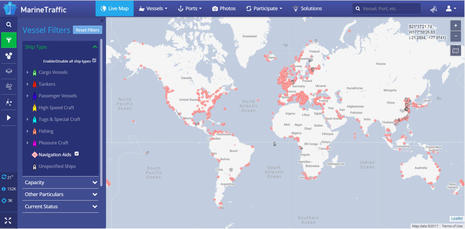 The opening Marine Traffic screenshot shows the 152,552 active AIS transceivers the service was tracking around the world one recent morning, and note that MT misses many vessels because the data is provided mostly by volunteers. So AIS is being used a lot, and moreover the system has proven itself so robust that in recent years the authorities have encouraged expanded uses like AIS aids to navigation (and AIS MOB beacons).
The opening Marine Traffic screenshot shows the 152,552 active AIS transceivers the service was tracking around the world one recent morning, and note that MT misses many vessels because the data is provided mostly by volunteers. So AIS is being used a lot, and moreover the system has proven itself so robust that in recent years the authorities have encouraged expanded uses like AIS aids to navigation (and AIS MOB beacons).
The filtered Marine Traffic screenshot above shows that AIS aids to navigation (AtoNs) are now active in many places, and I'm happy to report that every AIS source and display I'm testing on Gizmo handles these AIS AtoNs well, with one significant exception.
Garmin still not displaying AIS AtoNs
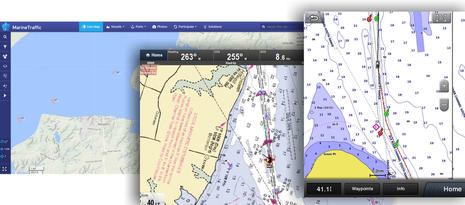 When I wrote about AIS AtoNs in early 2015 I did not know how well they showed up on navigation screens, mainly because there weren't any in my home waters. But now several synthetic AIS AtoNs further mark significant nav aids along the Maine coast, and I recently encountered numerous AIS AtoNs while on the classic snowbird route to Norfolk, Virginia.
When I wrote about AIS AtoNs in early 2015 I did not know how well they showed up on navigation screens, mainly because there weren't any in my home waters. But now several synthetic AIS AtoNs further mark significant nav aids along the Maine coast, and I recently encountered numerous AIS AtoNs while on the classic snowbird route to Norfolk, Virginia.
In the screen collage above, Marine Traffic is showing five upper Chesapeake AIS AtoNs, three of which were being overlaid on a raster chart by Gizmo's test Raymarine eS128 while we motored down the marked channel. But the Garmin 7612 receiving AIS data from the same NMEA 2000 source, a Vesper XB8000, is not showing the "ER" AIS AtoN. In fact, it's never displayed any AIS AtoN, apparently because Garmin MFDs still do not know how to translate the specific NMEA 2000 PGN that contains the AtoN information.
Note in the comments to that 2015 AtoN entry that a Garmin user could not see known AIS AtoNs around Key West, and Garmin acknowledged the problem thusly:
According to the engineers, that PGN {129041, corresponding to AIS AtoN message 21} isn't currently supported by the AIS 600 and also isn't supported by the MFD's chartplotters.
So for Garmin it's a double problem, though it would seem fairly easy to add PGN 129041 support in an MFD update, and apparently even the AIS 600 can be updated remotely. In fact, Garmin just made marine software updating a lot easier with the new ActiveCaptain app system, but the company also recently acknowledged that "we still do not support this feature {AIS AtoNs over N2K} today and are (still) working on a fix."
Meanwhile, all four of Gizmo's current NMEA 2000 AIS sources provide AtoN information and a whole lot of MFDs, apps and charting programs display it. The examples collaged above are iNavX on an iPad, the Raymarine Axiom 7 running new Lighthouse 3, and the Em-Trak B400 Class B AIS (that's particularly good for a pro look at AtoN info), but similar is true on Furuno TZT2, Simrad NSS evo2 and every other AIS display I have, except Garmin's.
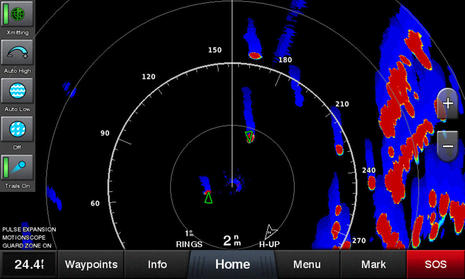 But is it dangerous not to see AIS AtoNs on your Garmin display? No, I think that exaggerates the issue a lot, and actually I have not yet used such AtoNs as part of my own navigation process. On the other hand, picture how this perfectly fine Garmin Fantom 24 radar screen -- now with a nice onscreen control bar -- could be a little more useful if one or more of those targets was a real or synthetic AIS AtoN that showed.
But is it dangerous not to see AIS AtoNs on your Garmin display? No, I think that exaggerates the issue a lot, and actually I have not yet used such AtoNs as part of my own navigation process. On the other hand, picture how this perfectly fine Garmin Fantom 24 radar screen -- now with a nice onscreen control bar -- could be a little more useful if one or more of those targets was a real or synthetic AIS AtoN that showed.
Also, be aware that one nifty use of virtual AIS AtoNs -- which can be quickly set up on shore, often from towers already transmitting synthetic AtoNs -- is to rapidly mark new navigation dangers, like a recently sunken vessel in a channel. If you're a Garmin MFD user with a NMEA 2000 AIS source, perhaps some more polite customer feedback will get AIS AtoN display pushed up their to-do list.
Navico, McMurdo & AMEC Class B problem?
 Now we'll discuss an entirely different AIS issue that may not turn out to be a real issue. So consider this as a head's up to owners of Navico NAIS-500, AMEC Camino 108, and McMurdo SmartFind M10 Class B AIS transceivers, but they should not jump to conclusions. What's happening is that all three of those models are based on an AIS transceiver module manufactured by AMEC, and another AIS manufacturer recently reported what seem like significant performance issues with that module.
Now we'll discuss an entirely different AIS issue that may not turn out to be a real issue. So consider this as a head's up to owners of Navico NAIS-500, AMEC Camino 108, and McMurdo SmartFind M10 Class B AIS transceivers, but they should not jump to conclusions. What's happening is that all three of those models are based on an AIS transceiver module manufactured by AMEC, and another AIS manufacturer recently reported what seem like significant performance issues with that module.
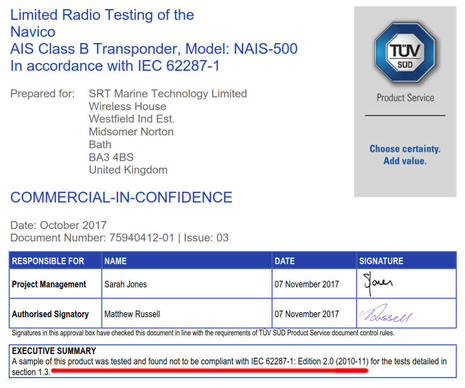 In fact, SRT Marine Systems believes that the AMEC module fails to comply with the Class B AIS certification standard, they commissioned a test by independent TÜV SÜD which confirms that conclusion (above), and last week they forwarded their findings to AIS regulators in the U.S., Europe, Canada, Australia, and New Zealand!
In fact, SRT Marine Systems believes that the AMEC module fails to comply with the Class B AIS certification standard, they commissioned a test by independent TÜV SÜD which confirms that conclusion (above), and last week they forwarded their findings to AIS regulators in the U.S., Europe, Canada, Australia, and New Zealand!
This is discomforting news in at least two different ways. If the AMEC module is truly non-compliant, how did it get certified in the first place and what are AMEC, Navico, and McMurdo going to do about devices already in the field? But then again, was SRT justified in testing and reporting a competitor's product, and will that become a messy norm in the complex world of certified marine communications products?
Again, please don't jump to conclusions either way. The good news is that the certified marine communications world now has to figure out exactly what's going on here, and we should eventually learn the results. In the meantime, let's take a closer look at AIS certification and also at how the affected companies are responding to SRT's report.
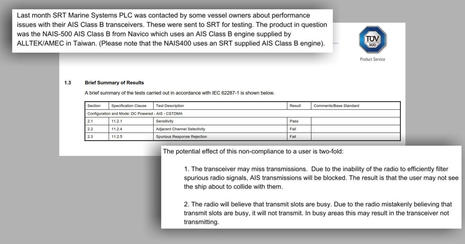 First, SRT agreed to share PDFs of their statement regarding Navico-AMEC Class B AIS emailed to Panbo on Nov. 3rd and also TUV's limited test of a Navico NAIS-500 just then completed. One thing you'll learn is that this issue purportedly came to SRT as NAIS-500 devices mistakenly sent in by dissatisfied customers who thought SRT made them. (SRT did make Navico's previous NAIS-400, and so the mistake also highlights the issue's confusing competitive angle.)
First, SRT agreed to share PDFs of their statement regarding Navico-AMEC Class B AIS emailed to Panbo on Nov. 3rd and also TUV's limited test of a Navico NAIS-500 just then completed. One thing you'll learn is that this issue purportedly came to SRT as NAIS-500 devices mistakenly sent in by dissatisfied customers who thought SRT made them. (SRT did make Navico's previous NAIS-400, and so the mistake also highlights the issue's confusing competitive angle.)
Additionally, collaged above are the two (of many) IEC 62287 criteria that failed in TUV's testing of the NAIS-500 -- Adjacent Channel Selectivity and Spurious Response Rejection -- and SRT's explanation of what those failures could mean to a NAIS-500 user. There's a lot of engineering and testing nuances to all this, but an expert I consulted said that the results are indeed distressing if the test was valid.
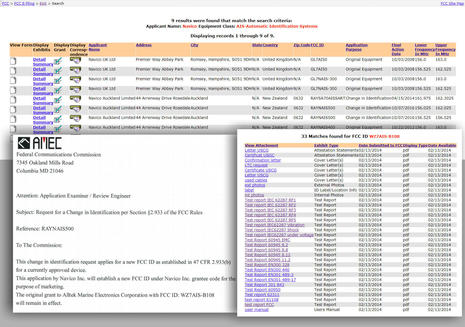 My effort to better understand this situation included a search of the FCC's OET authorized AIS database, one of the beauties of the certification process. I learned that while Navico's NAIS-500 was only authorized in Octoberabys 2016, it's "electronically identical" to the AMEC Camino that was FCC approved in early 2014.
My effort to better understand this situation included a search of the FCC's OET authorized AIS database, one of the beauties of the certification process. I learned that while Navico's NAIS-500 was only authorized in Octoberabys 2016, it's "electronically identical" to the AMEC Camino that was FCC approved in early 2014.
Therefore, that long list of downloadable test documents at lower right above applies to the NAIS-500 as well as the Camino 108 series (and the McMurdo M10), and if you care to dig around, I believe you'll be awed by the depth and breadth of testing involved. For instance, what TUV tested only comprises a small fraction of a single, though critical report (AMEC Camino test by Phoenix PDF here).
It's no surprise that such testing takes many months and costs well over $100,000, that an automated mesh communications system so tightly regulated works well, and also that many marine electronics brands like Navico turn to specialists like SRT and AMEC for certified AIS products.
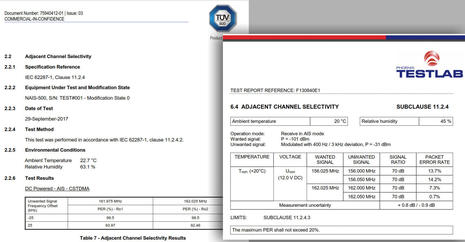 Now we're down to the conflict at the heart of this issue. The TUV test at left indicates that when the NAIS-500 is exposed to transmissions on an adjacent VHF channel, its PER -- that's Packet Error Rate, as is in AIS messages failing to deliver -- approaches an abysmal 100%. Yet the Phoenix Testlab results from 2014 show that the purportedly identical electronic module passed the maximum 20% PER, in most cases by a lot.
Now we're down to the conflict at the heart of this issue. The TUV test at left indicates that when the NAIS-500 is exposed to transmissions on an adjacent VHF channel, its PER -- that's Packet Error Rate, as is in AIS messages failing to deliver -- approaches an abysmal 100%. Yet the Phoenix Testlab results from 2014 show that the purportedly identical electronic module passed the maximum 20% PER, in most cases by a lot.
Explanations for this inconsistency can be extreme, like the notion that AMEC submitted special "golden" devices for testing, or that TUV worked with an oddball lemon. The norm, incidentally, is for a company like AMEC to submit numerous off-the-shelf units for the testing house to choose from, and SRT says they supplied all five of their returned or purchased NAIS-500's to TUV, all of which had tested badly in their own lab.
There seem to be many less dark and purposeful explanations, however, and they're covered in AMEC's response to SRT's findings. But first, let me add that when I learned that the problems applied to AMEC AIS transceivers that have been out in the field since 2014, I especially wondered if any users had detected them.
Understand that a somewhat frightening aspect to the receiver problems SRT and TUV detected -- and actually one of the reasons I feel obliged to write about them, and another reason SRT was justified to blow the whistle -- is that the affected AIS transceiver might work fine much of the time, but much less well in certain circumstances like areas with lots of AIS and other RF traffic.
But while it might take a lot of users to detect a subtle performance issue, Doug Miller -- the highly reputable (in my opinion) proprieter of Milltech Marine -- had a lot to say about his positive experiences with AMEC Caminos, paraphased here:
I sell a lot of AIS products. Well over 12,000 units so far and I sell lots of different brands based on OEM technologies from SRT, AMEC, Vesper and others. I sell what customers want based on features, price, brand, connectivity and essentially anything that matters to the customer. I don't try to steer customers one way or another. I try to honestly represent every product and let the customer choose. Based on that our most successful transponder brands are AMEC and Vesper...
...They are tireless. I send them feedback or a customer question and I get answers right away. If I ask for a feature based on customer feedback, both companies are quick to respond and in many cases implementing a fix or new feature. Both companies are very product quality driven. When I have had issues with defects or functionality concerns, both have been insanely quick to get the issues resolved...
...we have never had a single customer report either of these issues as a problem. In fact, the CAMINO-108 has consistently had a 5-star review rating and we see very high customer satisfaction with the product. FYI, we publish all reviews for all products regardless of the rating. Customers are free to publish any review they want and there is no incentive to publish a review - good or bad.
...I find this whole situation with SRT very sad and to be honest very discouraging... Given the chance to rectify the issues, I know AMEC would do everything possible to fix any so-called issues. But again, these issues have never been raised by any of my customers.
And what about McMurdo and Navico, who only heard about the possible problem with their AMEC made and certified Class B AIS transponders very recently? McMurdo told me by phone late last week that they have temporarily taken the Smartfind M10 off the market until the issue is resolved, and Navico already had the following press release ready when I contacted them:
Navico's number one priority is the safe use and performance of its systems and products. We introduced the NAIS-400 Class-B AIS to the market 5 years ago and have not received any reports or concerns regarding its performance over the thousands of units shipped to our partners and consumers around the world. In addition, the NAIS-500 Class-B AIS, introduced earlier this year, has been tested and certified by an approved independent test lab.
Recently we have been made aware by SRT, our former supplier and a competitive AIS manufacturer, that they have concerns about the NAIS-500 Class-B AIS Transceiver. We are in the process of analyzing this report and have sent units to an additional approved independent lab for review.
If Navico finds through further testing or analysis of reports that any legitimate performance issues exist, we will take immediate steps to ensure these issues are addressed.
So the brands selling AMEC Class B technology are taking this issue quite seriously, but not surprisingly it's the AMEC crew who have burned the midnight oil lately. On Saturday I received this downloadable 24-page PDF titled AMEC's Statement on Panbo, and it's loaded with details about possible flaws in the analysis done by SRT and TUV.
In fact, AMEC even claims to have used the same Spurious Response Rejection testing protocol on SRT-made Class B transceivers, and that their PER failed badly, as illustrated below.
I have no idea how this situation will be resolved by the regulators and companies involved. But I do trust that it will be resolved, and I'll certainly try to report on developments as they happen (in the comments below, where you and all parties are encouraged to participate). Corporate embarrassment, product recalls, and maybe worse do seem possible, but, overall, I'm confident and thankful that the highly engineered and regulated AIS system will carry on just fine.
PS 11/17: SRT sent in a PDF titled SRT comments on Alltek AIS Class B Non-compliance Statement

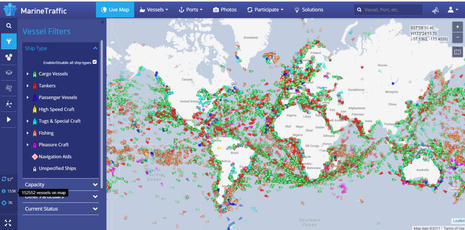
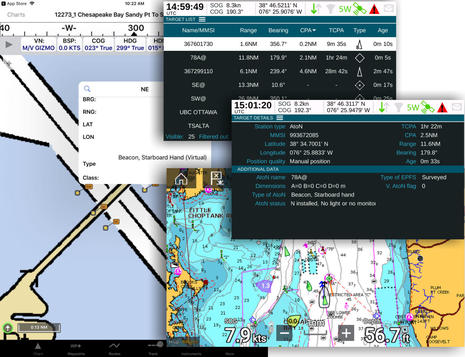
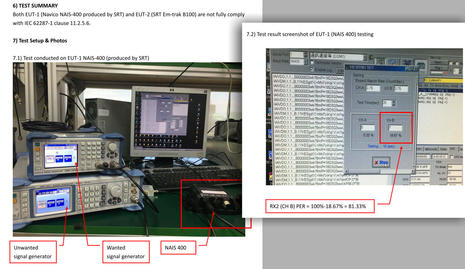
 Share
Share
Hi Ben,
Under one of my other hats I've been heavily involved in evaluating VHF & HF communication radios for their compliance with various (mostly NTIA) technical requirements. One VERY prominent thing I've noted is the serious distain most marketing folks have with the entire area - statements like "none of our customers have ever reported any issues..." are quite common - but the "issues" their customers ARE reporting are often written off to things other than where they really belong - receiver problems (selectivity in particular) are quite subtle, and unless you have a trained ear or an extensive test equipment setup, they can be quite difficult to deal with.
An example - I had a Standard-Horizon GX1600 on Atsa for almost two years, but it's lack of selectivity and front-end IMD performance finally drove me to replace it with an Icom M506, which has significantly better performance. But few people who weren't long-time radio techs listening to that radio would have recognized what the true problems were.
For digital services, the problem is even worse, because even a "trained ear" has little to work with other than a feeling of "inadequate performance sometimes" - nobody I know has the tools aboard to properly diagnose these problems, so we are consigned to reading about actual lab testing - and I would examine even the lab testing very carefully!
In the two-way radio world, I've been handed lab test results from "Certified labs" that were demonstrably false in one or more areas - usually things like receiver selectivity and spurious response. It is my firm belief that you can buy a lab report that says whatever you want it to say, as long as there is no risk of having the government get interested in it.
Goofing off in Martinique today - back in FL by the weekend. Atsa is getting new water tanks in Deltaville :)